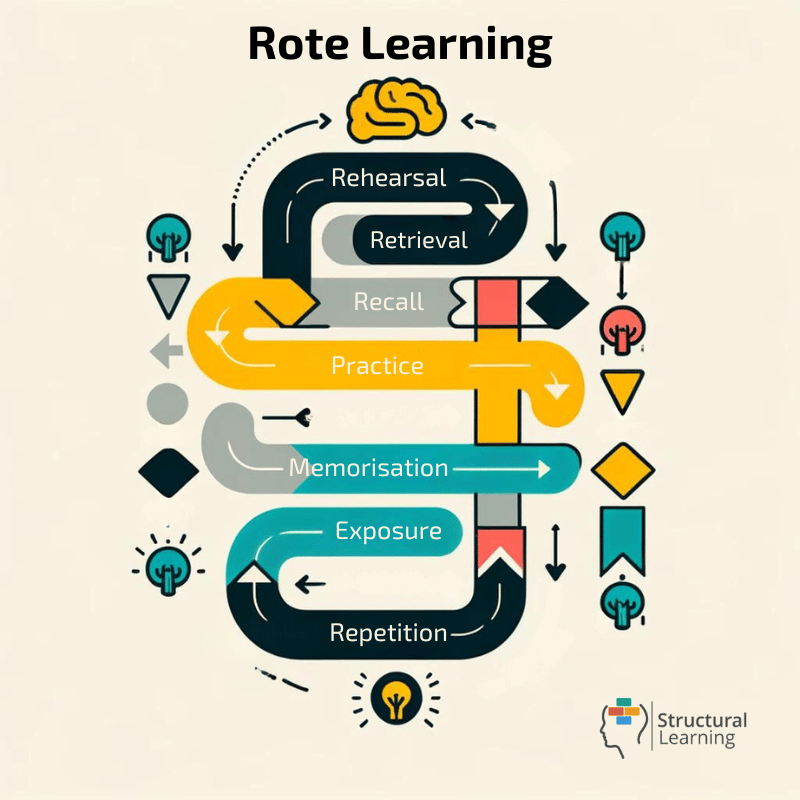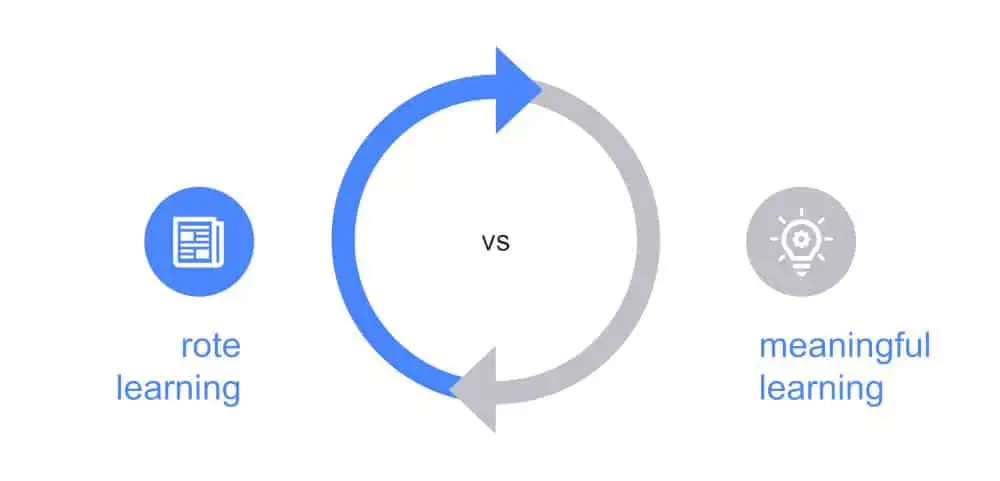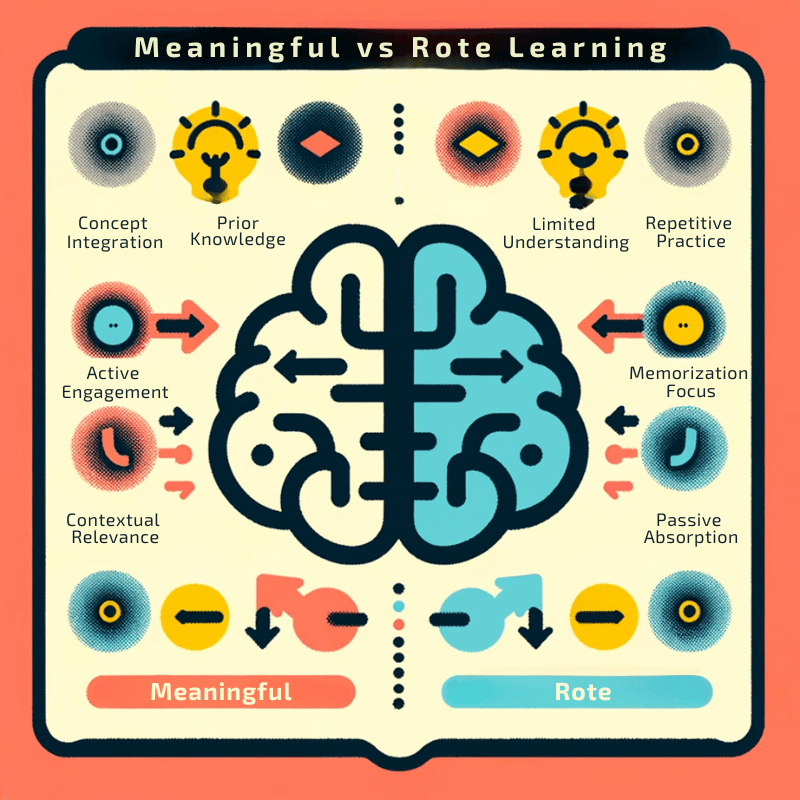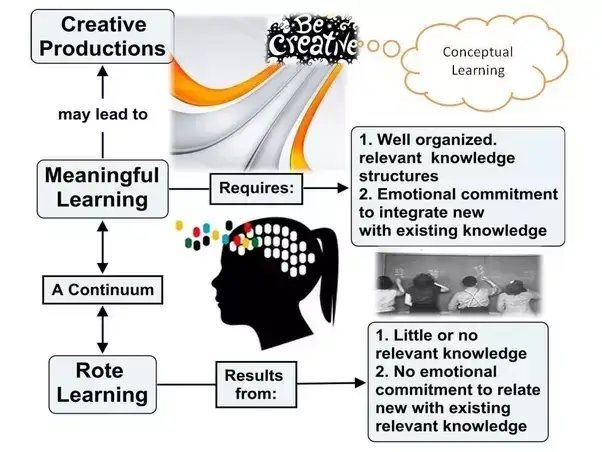Rote Learning
Learn the basics of rote learning - a memorisation method using repetition to help master key facts, formulas, and foundational knowledge.


Learn the basics of rote learning - a memorisation method using repetition to help master key facts, formulas, and foundational knowledge.
Rote learning is a memorization technique that involves repeating information over and over until it is committed to memory. It is often associated with the traditional style of education, where students are expected to simply repeat information without truly understanding it.
Rote learning is commonly used to remember facts, formulas, and other important details, but it is often criticized for not promoting deeper comprehension or critical thinking skills. In this article, we will explore the concept of rote learning, its potential benefits and drawbacks, and alternative learning strategies that may be more effective in the long run.
Rote learning is a method that involves the memorization of specific information through repetition. The primary benefits of rote learning include its effectiveness in memorizing specific information such as dates, facts, or figures.
This method can also be useful in learning music scales or historical dates. Rote learning can be advantageous for adults in certain contexts, such as when they need to quickly recall specific information in their professional lives.
For example, medical professionals may benefit from rote learning when memorizing drug dosages or the symptoms of particular diseases. Additionally, adults learning a new language may find rote learning helpful for memorizing vocabulary and grammatical rules.
The benefits of rote learning include its effectiveness in memorization and its usefulness in certain contexts for adults in professional and educational settings.
As we have seen, rote learning is a traditional memorization technique where information is repeated until it's firmly memorized. It's often employed in educational settings to help children and students embed basic knowledge.
Concrete Examples of Rote Learning include:
Spelling Games:
Repetition of the Alphabet:
Memorizing Multiplication Tables:
Memory Games:
Multi-Sensory Rote Learning:
Incorporating these techniques, educators can make rote learning more engaging and effective, helping students to firmly grasp foundational knowledge.
Rote learning, also known as memorization or repetition learning, is a technique that involves the memorization of information through repetition without necessarily understanding the meaning or significance of the information.
This method has been used for centuries in education and has been a common practice in many cultures. There are various techniques and strategies that can be employed to enhance the effectiveness of rote learning, and understanding these methods can be beneficial in educational settings.

The memorization technique discussed in the next heading emphasizes the importance of rote repetition for strengthening memory and long-term retention. Rote repetition involves repeating information over and over again until it becomes ingrained in long-term memory. This process is crucial for committing information to memory and allowing for automatic processes to take over, freeing up working memory for more complex higher-order skills.
Committing information to long-term memory has many benefits, as it allows individuals to cheat the limitations of working memory. Once information is stored in long-term memory, it can be accessed and utilized without the need to constantly rehearse or hold it in working memory. This process is essential for more complex cognitive tasks and activities that require deep conceptual understanding and problem-solving skills.
Rote repetition plays a critical role in strengthening memory and long-term retention, while also freeing up working memory for higher-order skills. Committing information to long-term memory is essential for overcoming the limitations of working memory and allowing for more advanced cognitive processes to take place.
Spaced repetition is a learning technique that involves spacing out review of material over increasing intervals of time. This method has been shown to improve knowledge retention compared to traditional learning methods.
In elearning, spaced repetition can be integrated by using algorithms to schedule review sessions of previously learned material at optimal times. This allows learners to remember information more effectively and for longer periods of time.
Many Elearning platforms utilize spaced repetition by incorporating features such as personalized quizzes and flashcards. These tools prompt learners to review information at specific intervals, reinforcing their memory of the material. This integration enhances the overall learning experience, leading to improved knowledge retention and long-term recall.
In the workplace, spaced repetition can be used to enhance rote learning by systematically reviewing important information at regular intervals. This ensures that employees retain critical knowledge and skills necessary for their roles.
By incorporating spaced repetition into workplace learning, organizations can improve the effectiveness of training programs and enhance employee performance.
Overall, the spaced repetition technique in elearning offers significant benefits for knowledge retention and can be effectively utilized to enhance rote learning in the workplace.

In the landscape of secondary education, a balance between rote memorization and critical thinking is essential for meaningful learning. Teachers often navigate this terrain, recognizing that while active learning strategies engage students in higher-order thinking, foundational knowledge—sometimes built through rote learning—serves as the bedrock for such critical engagement.
The journey from memorizing facts to applying them in complex ways mirrors the cognitive development stages outlined in educational psychology. Rote memorization, although sometimes viewed as mechanical, equips students with the necessary vocabulary and basic concepts that form the scaffold for critical analysis and synthesis.
It is this interplay of acquiring knowledge and then using it as a tool for deeper inquiry that constitutes the heart of meaningful learning.
In Special Education, this dynamic is especially pertinent; educators must tailor their approaches to ensure that students with diverse learning needs can access and apply knowledge in ways that resonate with their unique learning profiles.
Engaging students in critical thinking does not negate the importance of rote learning; instead, it emphasizes the need for a firm grasp of fundamental knowledge before one can evaluate, infer, or create anew. This cognitive groundwork is not just a stepping stone but a vital component of the educational process.
As such, educators aim to transcend the dichotomy of rote versus critical thinking, acknowledging that one feeds into the other. By fostering an environment where rote memorization acts as a precursor to critical thinking, teachers empower students to not only understand but also to question and extend their knowledge.
Active learning, therefore, is not just about interaction and engagement, but also about ensuring that students have the necessary knowledge base to participate in such a dynamic educational experience fully.

In the fabric of 21st-century education, the role of rote learning is nuanced, with its suitability varying across different types of knowledge within the curriculum.
Epistemology, the theory of knowledge, suggests that certain cognitive skills benefit from the foundational support provided by rote learning.
When children commit basic facts to memory, they create a framework of previous knowledge that can be accessed for more complex tasks. This method can be especially beneficial in Special Education, where rote learning supports the development of memory pathways, aiding students who thrive as rote learners.
In secondary education, while the focus is increasingly on meaningful learning and deep understanding, there remains a clear place for rote learning.
Types of Knowledge Suited to Rote Learning:
Rote learning, when employed effectively, can anchor students' learning experiences, providing them with the necessary tools to engage in higher-level cognitive tasks. It acts as a stepping stone towards achieving a comprehensive educational journey.

As we have explored, the rote method of learning is a traditional approach that involves memorizing information through repetition without necessarily understanding the underlying concepts. This method has been a subject of debate among educators, with proponents arguing that it is an effective way to quickly and efficiently memorize facts, while critics claim that it hinders deeper understanding and critical thinking skills.
In this section, we will explore the advantages and disadvantages of using the rote method of learning.
While rote learning is instrumental in building a base of knowledge, it's part of a broader educational strategy that includes critical thinking and creative problem-solving to foster a comprehensive understanding.
Recognizing these disadvantages is crucial for educators to balance rote learning with more interactive and thought-provoking teaching methods.

Rote learning in language acquisition involves the memorization of vocabulary and grammar rules through repetition and rehearsal. This method can be challenging as it requires a significant amount of time and effort to commit information to memory. The process of rote learning can also be monotonous and may lead to a lack of meaningful understanding or application of the language.
However, rote learning can be beneficial in language acquisition as it provides a foundation for language skills and helps learners to quickly memorize new vocabulary and grammar rules. It also encourages consistent practice, which can improve fluency and proficiency in a language.
One drawback of rote learning is the potential for forgetting over time, as information that is not regularly reinforced may be lost. Additionally, the reliance on rote learning may hinder adaptability in using the language in real-life situations.
Overall, while rote learning can aid in memorization and initial language acquisition, it is essential to supplement this method with other approaches to ensure a deeper understanding and long-term retention of language skills.
Rote learning is deeply rooted in neuroscience. When we repeatedly practice a certain activity or information, the connections between neurons in the brain are strengthened, resulting in more efficient retrieval of that information.
However, a potential downside of rote learning is the potential for a large database size, as every piece of information we learn adds to our memory store. This can result in slower recognition speed and increased difficulty in accessing specific information.
To address this, a compensating mechanism of forgetting is essential in learning. This allows the brain to clear out unnecessary information and make room for new learning.
Neural networks have the potential to address the challenges of rote learning by mimicking the brain's ability to process and store information. However, controlling their abilities is currently a major difficulty. While neural networks are capable of learning and adapting, they can also fall into the trap of overfitting and becoming too specialized in specific tasks, hindering generalizability.
Understanding the neural basis of rote learning and harnessing the power of neural networks holds promise for optimizing the learning process in the future.

Rote learning has its limitations in that it focuses on memorization rather than deeper understanding. While rote learning can be useful for the acquisition of basic facts and information, it may hinder the development of higher-order thinking skills such as critical thinking and problem-solving.
Modern teaching methods like metacognition and associative learning provide alternatives to rote memorization by encouraging students to think more deeply about the information they are learning and make connections between different pieces of knowledge.
Educators can move beyond rote learning and foster higher-level thinking in their classrooms by incorporating strategies and techniques that promote critical thinking and problem-solving. This can be achieved through activities that require students to analyze and evaluate information, rather than simply memorize it.
Encouraging students to ask questions, think critically about the material, and apply their knowledge to new situations can help to develop their higher-order thinking skills. By embracing modern teaching methods and moving beyond rote learning, educators can help students achieve deeper understanding and meaningful learning.

While rote learning has long been a staple of education, its effectiveness increases when combined with active learning strategies that engage students in deeper processing. Rather than viewing rote memorization as outdated or ineffective, educators can integrate it with interactive techniques to reinforce knowledge while promoting higher-order thinking skills.
By incorporating structured retrieval practice and interactive elements, rote learning becomes an essential tool rather than an outdated method. This blended approach ensures students retain essential knowledge while developing analytical and problem-solving abilities.

These papers provide diverse insights into the role and effectiveness of rote learning in various educational contexts, from language acquisition to programming and special education.
1. Prolonged Rote Learning Produces Delayed Memory Facilitation and Metabolic Changes in the Hippocampus of the Ageing Human Brain by R. Roche et al. (2009)
This study reveals that prolonged rote learning can enhance memory and promote neuronal plasticity, particularly for verbal/episodic material, in the aging brain. It underscores the importance of rote memory as a foundational skill for maintaining cognitive resources in advanced age.
2. Achieving Unconscious Recall of Kanji: Can Rote Learning Help? by Dallas Nesbitt (2009)
Nesbitt's study highlights how guided rote-learning strategies can aid beginners in learning Japanese kanji. It suggests that rote learning builds neural pathways to procedural memory, playing a crucial role in the learning journey and facilitating recall.
3. Keyword Mnemonics Versus Rote Rehearsal: Learning Concrete and Abstract Foreign Words by Experienced and Inexperienced Learners by J. V. Hell, A. Mahn (1997)
This research compares the efficacy of keyword mnemonics and rote rehearsal in foreign language learning. It shows that for experienced learners, rote learning can be more effective than keyword methods, highlighting its role in developing higher-level critical thinking skills.
4. "Memo" Functions and Machine Learning by D. Michie (1968)
Michie's paper presents a perspective on rote learning in the context of programming language efficiency. It discusses how a simple rote-learning facility within programming can significantly improve the efficiency of programs during execution.
5. Facilitative Effect of Mnemonic Strategies on Multiple-Associate Learning in EMR Children by D. Ross, S. Ross (1978)
This study examines the effects of mnemonic strategies compared to rote repetition in improving learning in children with educational and mental retardation (EMR). It finds that imagery techniques are more effective than rote learning in enhancing multiple-associate learning.
Rote learning is a memorization technique that involves repeating information over and over until it is committed to memory. It is often associated with the traditional style of education, where students are expected to simply repeat information without truly understanding it.
Rote learning is commonly used to remember facts, formulas, and other important details, but it is often criticized for not promoting deeper comprehension or critical thinking skills. In this article, we will explore the concept of rote learning, its potential benefits and drawbacks, and alternative learning strategies that may be more effective in the long run.
Rote learning is a method that involves the memorization of specific information through repetition. The primary benefits of rote learning include its effectiveness in memorizing specific information such as dates, facts, or figures.
This method can also be useful in learning music scales or historical dates. Rote learning can be advantageous for adults in certain contexts, such as when they need to quickly recall specific information in their professional lives.
For example, medical professionals may benefit from rote learning when memorizing drug dosages or the symptoms of particular diseases. Additionally, adults learning a new language may find rote learning helpful for memorizing vocabulary and grammatical rules.
The benefits of rote learning include its effectiveness in memorization and its usefulness in certain contexts for adults in professional and educational settings.
As we have seen, rote learning is a traditional memorization technique where information is repeated until it's firmly memorized. It's often employed in educational settings to help children and students embed basic knowledge.
Concrete Examples of Rote Learning include:
Spelling Games:
Repetition of the Alphabet:
Memorizing Multiplication Tables:
Memory Games:
Multi-Sensory Rote Learning:
Incorporating these techniques, educators can make rote learning more engaging and effective, helping students to firmly grasp foundational knowledge.
Rote learning, also known as memorization or repetition learning, is a technique that involves the memorization of information through repetition without necessarily understanding the meaning or significance of the information.
This method has been used for centuries in education and has been a common practice in many cultures. There are various techniques and strategies that can be employed to enhance the effectiveness of rote learning, and understanding these methods can be beneficial in educational settings.

The memorization technique discussed in the next heading emphasizes the importance of rote repetition for strengthening memory and long-term retention. Rote repetition involves repeating information over and over again until it becomes ingrained in long-term memory. This process is crucial for committing information to memory and allowing for automatic processes to take over, freeing up working memory for more complex higher-order skills.
Committing information to long-term memory has many benefits, as it allows individuals to cheat the limitations of working memory. Once information is stored in long-term memory, it can be accessed and utilized without the need to constantly rehearse or hold it in working memory. This process is essential for more complex cognitive tasks and activities that require deep conceptual understanding and problem-solving skills.
Rote repetition plays a critical role in strengthening memory and long-term retention, while also freeing up working memory for higher-order skills. Committing information to long-term memory is essential for overcoming the limitations of working memory and allowing for more advanced cognitive processes to take place.
Spaced repetition is a learning technique that involves spacing out review of material over increasing intervals of time. This method has been shown to improve knowledge retention compared to traditional learning methods.
In elearning, spaced repetition can be integrated by using algorithms to schedule review sessions of previously learned material at optimal times. This allows learners to remember information more effectively and for longer periods of time.
Many Elearning platforms utilize spaced repetition by incorporating features such as personalized quizzes and flashcards. These tools prompt learners to review information at specific intervals, reinforcing their memory of the material. This integration enhances the overall learning experience, leading to improved knowledge retention and long-term recall.
In the workplace, spaced repetition can be used to enhance rote learning by systematically reviewing important information at regular intervals. This ensures that employees retain critical knowledge and skills necessary for their roles.
By incorporating spaced repetition into workplace learning, organizations can improve the effectiveness of training programs and enhance employee performance.
Overall, the spaced repetition technique in elearning offers significant benefits for knowledge retention and can be effectively utilized to enhance rote learning in the workplace.

In the landscape of secondary education, a balance between rote memorization and critical thinking is essential for meaningful learning. Teachers often navigate this terrain, recognizing that while active learning strategies engage students in higher-order thinking, foundational knowledge—sometimes built through rote learning—serves as the bedrock for such critical engagement.
The journey from memorizing facts to applying them in complex ways mirrors the cognitive development stages outlined in educational psychology. Rote memorization, although sometimes viewed as mechanical, equips students with the necessary vocabulary and basic concepts that form the scaffold for critical analysis and synthesis.
It is this interplay of acquiring knowledge and then using it as a tool for deeper inquiry that constitutes the heart of meaningful learning.
In Special Education, this dynamic is especially pertinent; educators must tailor their approaches to ensure that students with diverse learning needs can access and apply knowledge in ways that resonate with their unique learning profiles.
Engaging students in critical thinking does not negate the importance of rote learning; instead, it emphasizes the need for a firm grasp of fundamental knowledge before one can evaluate, infer, or create anew. This cognitive groundwork is not just a stepping stone but a vital component of the educational process.
As such, educators aim to transcend the dichotomy of rote versus critical thinking, acknowledging that one feeds into the other. By fostering an environment where rote memorization acts as a precursor to critical thinking, teachers empower students to not only understand but also to question and extend their knowledge.
Active learning, therefore, is not just about interaction and engagement, but also about ensuring that students have the necessary knowledge base to participate in such a dynamic educational experience fully.

In the fabric of 21st-century education, the role of rote learning is nuanced, with its suitability varying across different types of knowledge within the curriculum.
Epistemology, the theory of knowledge, suggests that certain cognitive skills benefit from the foundational support provided by rote learning.
When children commit basic facts to memory, they create a framework of previous knowledge that can be accessed for more complex tasks. This method can be especially beneficial in Special Education, where rote learning supports the development of memory pathways, aiding students who thrive as rote learners.
In secondary education, while the focus is increasingly on meaningful learning and deep understanding, there remains a clear place for rote learning.
Types of Knowledge Suited to Rote Learning:
Rote learning, when employed effectively, can anchor students' learning experiences, providing them with the necessary tools to engage in higher-level cognitive tasks. It acts as a stepping stone towards achieving a comprehensive educational journey.

As we have explored, the rote method of learning is a traditional approach that involves memorizing information through repetition without necessarily understanding the underlying concepts. This method has been a subject of debate among educators, with proponents arguing that it is an effective way to quickly and efficiently memorize facts, while critics claim that it hinders deeper understanding and critical thinking skills.
In this section, we will explore the advantages and disadvantages of using the rote method of learning.
While rote learning is instrumental in building a base of knowledge, it's part of a broader educational strategy that includes critical thinking and creative problem-solving to foster a comprehensive understanding.
Recognizing these disadvantages is crucial for educators to balance rote learning with more interactive and thought-provoking teaching methods.

Rote learning in language acquisition involves the memorization of vocabulary and grammar rules through repetition and rehearsal. This method can be challenging as it requires a significant amount of time and effort to commit information to memory. The process of rote learning can also be monotonous and may lead to a lack of meaningful understanding or application of the language.
However, rote learning can be beneficial in language acquisition as it provides a foundation for language skills and helps learners to quickly memorize new vocabulary and grammar rules. It also encourages consistent practice, which can improve fluency and proficiency in a language.
One drawback of rote learning is the potential for forgetting over time, as information that is not regularly reinforced may be lost. Additionally, the reliance on rote learning may hinder adaptability in using the language in real-life situations.
Overall, while rote learning can aid in memorization and initial language acquisition, it is essential to supplement this method with other approaches to ensure a deeper understanding and long-term retention of language skills.
Rote learning is deeply rooted in neuroscience. When we repeatedly practice a certain activity or information, the connections between neurons in the brain are strengthened, resulting in more efficient retrieval of that information.
However, a potential downside of rote learning is the potential for a large database size, as every piece of information we learn adds to our memory store. This can result in slower recognition speed and increased difficulty in accessing specific information.
To address this, a compensating mechanism of forgetting is essential in learning. This allows the brain to clear out unnecessary information and make room for new learning.
Neural networks have the potential to address the challenges of rote learning by mimicking the brain's ability to process and store information. However, controlling their abilities is currently a major difficulty. While neural networks are capable of learning and adapting, they can also fall into the trap of overfitting and becoming too specialized in specific tasks, hindering generalizability.
Understanding the neural basis of rote learning and harnessing the power of neural networks holds promise for optimizing the learning process in the future.

Rote learning has its limitations in that it focuses on memorization rather than deeper understanding. While rote learning can be useful for the acquisition of basic facts and information, it may hinder the development of higher-order thinking skills such as critical thinking and problem-solving.
Modern teaching methods like metacognition and associative learning provide alternatives to rote memorization by encouraging students to think more deeply about the information they are learning and make connections between different pieces of knowledge.
Educators can move beyond rote learning and foster higher-level thinking in their classrooms by incorporating strategies and techniques that promote critical thinking and problem-solving. This can be achieved through activities that require students to analyze and evaluate information, rather than simply memorize it.
Encouraging students to ask questions, think critically about the material, and apply their knowledge to new situations can help to develop their higher-order thinking skills. By embracing modern teaching methods and moving beyond rote learning, educators can help students achieve deeper understanding and meaningful learning.

While rote learning has long been a staple of education, its effectiveness increases when combined with active learning strategies that engage students in deeper processing. Rather than viewing rote memorization as outdated or ineffective, educators can integrate it with interactive techniques to reinforce knowledge while promoting higher-order thinking skills.
By incorporating structured retrieval practice and interactive elements, rote learning becomes an essential tool rather than an outdated method. This blended approach ensures students retain essential knowledge while developing analytical and problem-solving abilities.

These papers provide diverse insights into the role and effectiveness of rote learning in various educational contexts, from language acquisition to programming and special education.
1. Prolonged Rote Learning Produces Delayed Memory Facilitation and Metabolic Changes in the Hippocampus of the Ageing Human Brain by R. Roche et al. (2009)
This study reveals that prolonged rote learning can enhance memory and promote neuronal plasticity, particularly for verbal/episodic material, in the aging brain. It underscores the importance of rote memory as a foundational skill for maintaining cognitive resources in advanced age.
2. Achieving Unconscious Recall of Kanji: Can Rote Learning Help? by Dallas Nesbitt (2009)
Nesbitt's study highlights how guided rote-learning strategies can aid beginners in learning Japanese kanji. It suggests that rote learning builds neural pathways to procedural memory, playing a crucial role in the learning journey and facilitating recall.
3. Keyword Mnemonics Versus Rote Rehearsal: Learning Concrete and Abstract Foreign Words by Experienced and Inexperienced Learners by J. V. Hell, A. Mahn (1997)
This research compares the efficacy of keyword mnemonics and rote rehearsal in foreign language learning. It shows that for experienced learners, rote learning can be more effective than keyword methods, highlighting its role in developing higher-level critical thinking skills.
4. "Memo" Functions and Machine Learning by D. Michie (1968)
Michie's paper presents a perspective on rote learning in the context of programming language efficiency. It discusses how a simple rote-learning facility within programming can significantly improve the efficiency of programs during execution.
5. Facilitative Effect of Mnemonic Strategies on Multiple-Associate Learning in EMR Children by D. Ross, S. Ross (1978)
This study examines the effects of mnemonic strategies compared to rote repetition in improving learning in children with educational and mental retardation (EMR). It finds that imagery techniques are more effective than rote learning in enhancing multiple-associate learning.